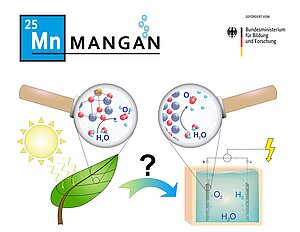The cluster project MANGAN, initiated in 2015 and coordinated at the MPI CEC, has recently completed. In this large scale project, funded by the German Federal Ministry of Education and Research (BMBF), a consortium of 25 research groups located at 15 institutes and universities tackled the question: could manganese based compounds be suitable electrocatalysts for water splitting in industrial hydrogen production? The choice of the element was inspired by photosynthesis, where a manganese-cluster, embedded in a protein-complex, catalyses this process in leaves.
To this end, experts from different fields cooperated and utilised a variety of synthesis- and analysis-techniques. In addition to the fabrication of different compounds and electrodes, the characterisation with regard to their catalytic properties in a unified fashion was one of the challenges. This was addressed with the development of a standardised characterisation protocol. Moreover, in the course of the project, characterisation techniques were enhanced and insights into the structure-function-relationship of different manganese compounds could be obtained.
Despite promising initial efficiency of some electrodes, it was found that the often-limited stability and conductivity of most manganese-based catalysts hinder their use in industrial applications. Nevertheless, even if the potential of manganese for an application as electrocatalysts for water splitting turned out to be rather low, approaching this project in an interdisciplinary manner lead to essential insights. The efficiency of the electrolysis process is not solely defined by the properties of the catalyst. It is rather a complex interplay of the involved components, such as mechanical and electrical compatibility of catalyst and electrode-support, influences of the electrolyte, and the geometry of the catalyst layer and its impact on stability and charge transport. Thus, important correlations were identified that lay a solid foundation for future research on concepts towards an optimised electrode design, which is applicable to ongoing work beyond manganese catalysts.
Further information about the project, the involved project partners, as well as related publications can be found on https://mangan.cec.mpg.de.

